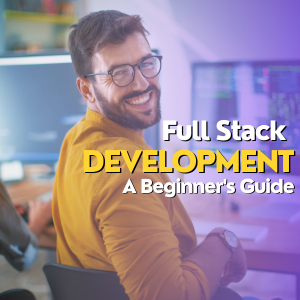Full stack development is one of the most in-demand skills for modern developers. It allows you to handle both frontend and backend development, making you versatile in creating complete web applications. In this guide, we’ll walk you through what full stack development is, the tools you’ll need, and how to get started on your journey.
What is Full Stack Development?
Full stack development refers to the ability to work on both the frontend (client-side) and backend (server-side) of a web application. As a full stack developer, you’re expected to be proficient in:
- Frontend: HTML, CSS, JavaScript, and frameworks like React or Angular.
- Backend: Node.js, Python, Ruby, PHP, or other server-side programming languages.
- Database Management: SQL or NoSQL databases like MongoDB, MySQL, or PostgreSQL.
Why Should You Learn Full Stack Development?
- Versatility: You can build an entire project, from user interfaces to databases, without relying on others for help.
- High Demand: Full stack developers are highly sought after because they can handle multiple aspects of web development.
- Job Opportunities: Whether you want to freelance or join a company, being a full stack developer opens more doors.
Essential Tools for Full Stack Development
Before diving into the coding, familiarize yourself with the tools that full stack developers use:
- Version Control: Git & GitHub for managing code and collaborating with other developers.
- Text Editor/IDE: VS Code is a popular choice due to its lightweight design and powerful extensions.
- Frontend Technologies: HTML, CSS, JavaScript, React.js, or Vue.js for building responsive and dynamic user interfaces.
- Backend Technologies: Node.js with Express for building APIs, or alternatively, Django (Python) or Laravel (PHP).
- Database: Learn both SQL (MySQL, PostgreSQL) and NoSQL (MongoDB) databases.
Step-by-Step Guide to Becoming a Full Stack Developer
- Learn Frontend Development
Start with the basics of HTML, CSS, and JavaScript. Once you’re comfortable, explore frontend frameworks like React or Angular to build more complex, interactive applications. - Master Backend Development
After mastering the frontend, start learning backend technologies like Node.js, Express, or Django. Learn how to create APIs, work with databases, and handle authentication. - Understand Databases
Learn the differences between SQL and NoSQL databases. For example, use MongoDB for NoSQL or MySQL for SQL. Practice creating, reading, updating, and deleting data. - Use Version Control (Git)
Get familiar with Git for managing your project’s source code. Push your code to GitHub and start collaborating with others. - Work on Projects
Build small, personal projects to apply what you’ve learned. Examples could be a personal portfolio, a blog, or a simple e-commerce website.
Conclusion
Becoming a full stack developer is a rewarding journey, but it takes time and consistent effort. Start by mastering one area (like frontend), and slowly expand your skills to include backend development and databases. With the right tools and mindset, you’ll be able to create full-fledged applications on your own.
Stay tuned for more in-depth tutorials and guides on mastering full stack development here on Noorfahad.dev. Happy coding!






Leave a Reply